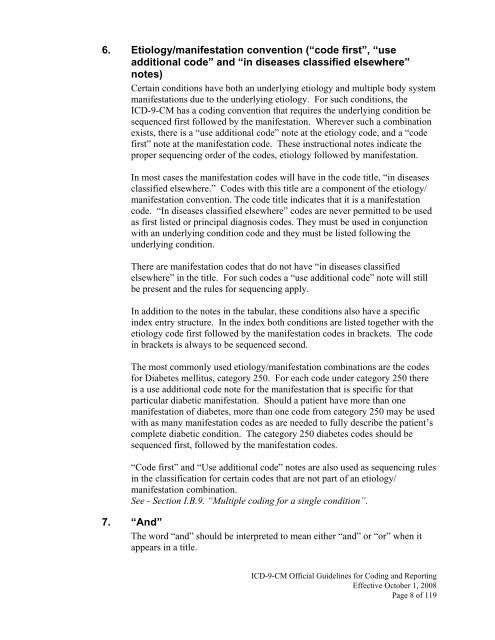ICD-9-CM Official Guidelines for Coding and Reporting - Office of ...
ICD-9-CM Official Guidelines for Coding and Reporting - Office of ...
ICD-9-CM Official Guidelines for Coding and Reporting - Office of ...
Create successful ePaper yourself
Turn your PDF publications into a flip-book with our unique Google optimized e-Paper software.
6. Etiology/manifestation convention (“code first”, “use<br />
additional code” <strong>and</strong> “in diseases classified elsewhere”<br />
notes)<br />
Certain conditions have both an underlying etiology <strong>and</strong> multiple body system<br />
manifestations due to the underlying etiology. For such conditions, the<br />
<strong>ICD</strong>-9-<strong>CM</strong> has a coding convention that requires the underlying condition be<br />
sequenced first followed by the manifestation. Wherever such a combination<br />
exists, there is a “use additional code” note at the etiology code, <strong>and</strong> a “code<br />
first” note at the manifestation code. These instructional notes indicate the<br />
proper sequencing order <strong>of</strong> the codes, etiology followed by manifestation.<br />
In most cases the manifestation codes will have in the code title, “in diseases<br />
classified elsewhere.” Codes with this title are a component <strong>of</strong> the etiology/<br />
manifestation convention. The code title indicates that it is a manifestation<br />
code. “In diseases classified elsewhere” codes are never permitted to be used<br />
as first listed or principal diagnosis codes. They must be used in conjunction<br />
with an underlying condition code <strong>and</strong> they must be listed following the<br />
underlying condition.<br />
There are manifestation codes that do not have “in diseases classified<br />
elsewhere” in the title. For such codes a “use additional code” note will still<br />
be present <strong>and</strong> the rules <strong>for</strong> sequencing apply.<br />
In addition to the notes in the tabular, these conditions also have a specific<br />
index entry structure. In the index both conditions are listed together with the<br />
etiology code first followed by the manifestation codes in brackets. The code<br />
in brackets is always to be sequenced second.<br />
The most commonly used etiology/manifestation combinations are the codes<br />
<strong>for</strong> Diabetes mellitus, category 250. For each code under category 250 there<br />
is a use additional code note <strong>for</strong> the manifestation that is specific <strong>for</strong> that<br />
particular diabetic manifestation. Should a patient have more than one<br />
manifestation <strong>of</strong> diabetes, more than one code from category 250 may be used<br />
with as many manifestation codes as are needed to fully describe the patient’s<br />
complete diabetic condition. The category 250 diabetes codes should be<br />
sequenced first, followed by the manifestation codes.<br />
“Code first” <strong>and</strong> “Use additional code” notes are also used as sequencing rules<br />
in the classification <strong>for</strong> certain codes that are not part <strong>of</strong> an etiology/<br />
manifestation combination.<br />
See - Section I.B.9. “Multiple coding <strong>for</strong> a single condition”.<br />
7. “And”<br />
The word “<strong>and</strong>” should be interpreted to mean either “<strong>and</strong>” or “or” when it<br />
appears in a title.<br />
<strong>ICD</strong>-9-<strong>CM</strong> <strong>Official</strong> <strong>Guidelines</strong> <strong>for</strong> <strong>Coding</strong> <strong>and</strong> <strong>Reporting</strong><br />
Effective October 1, 2008<br />
Page 8 <strong>of</strong> 119
















